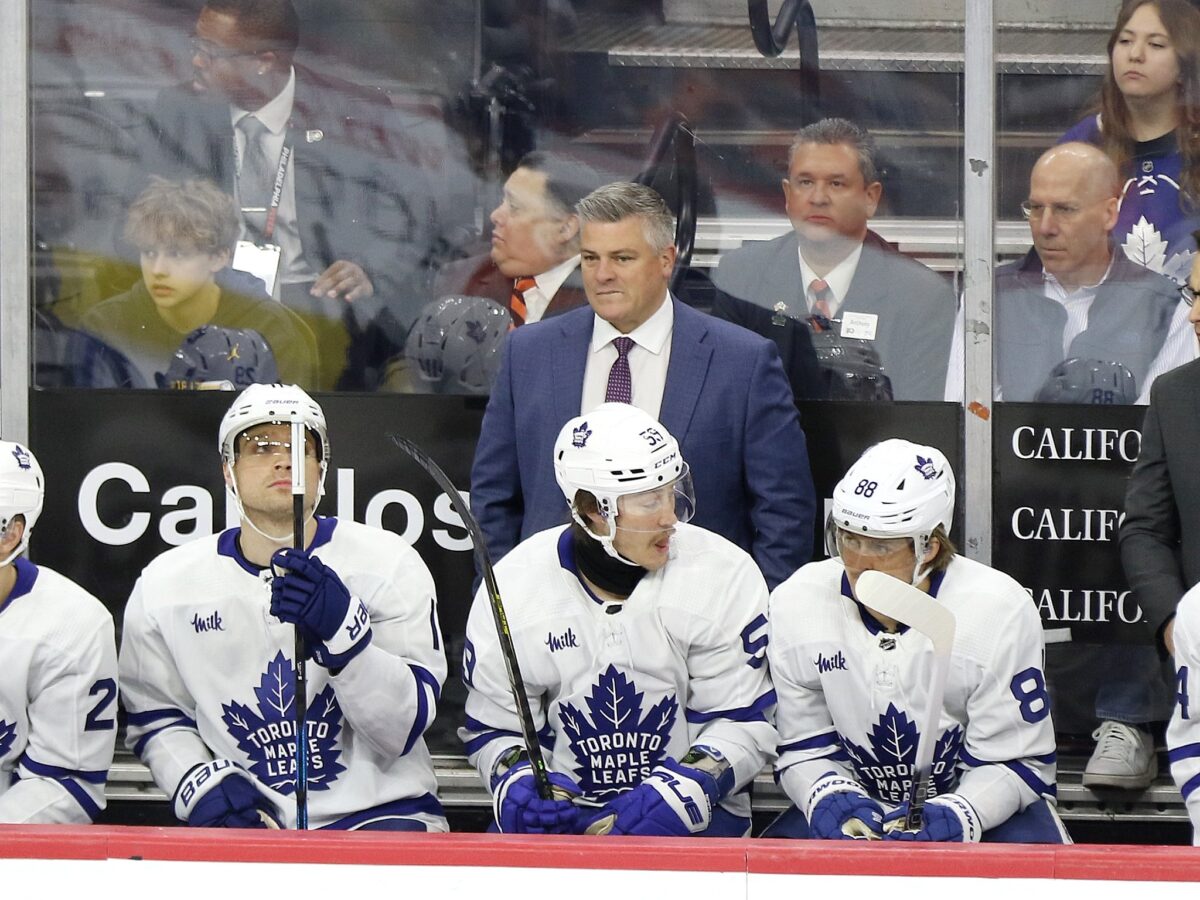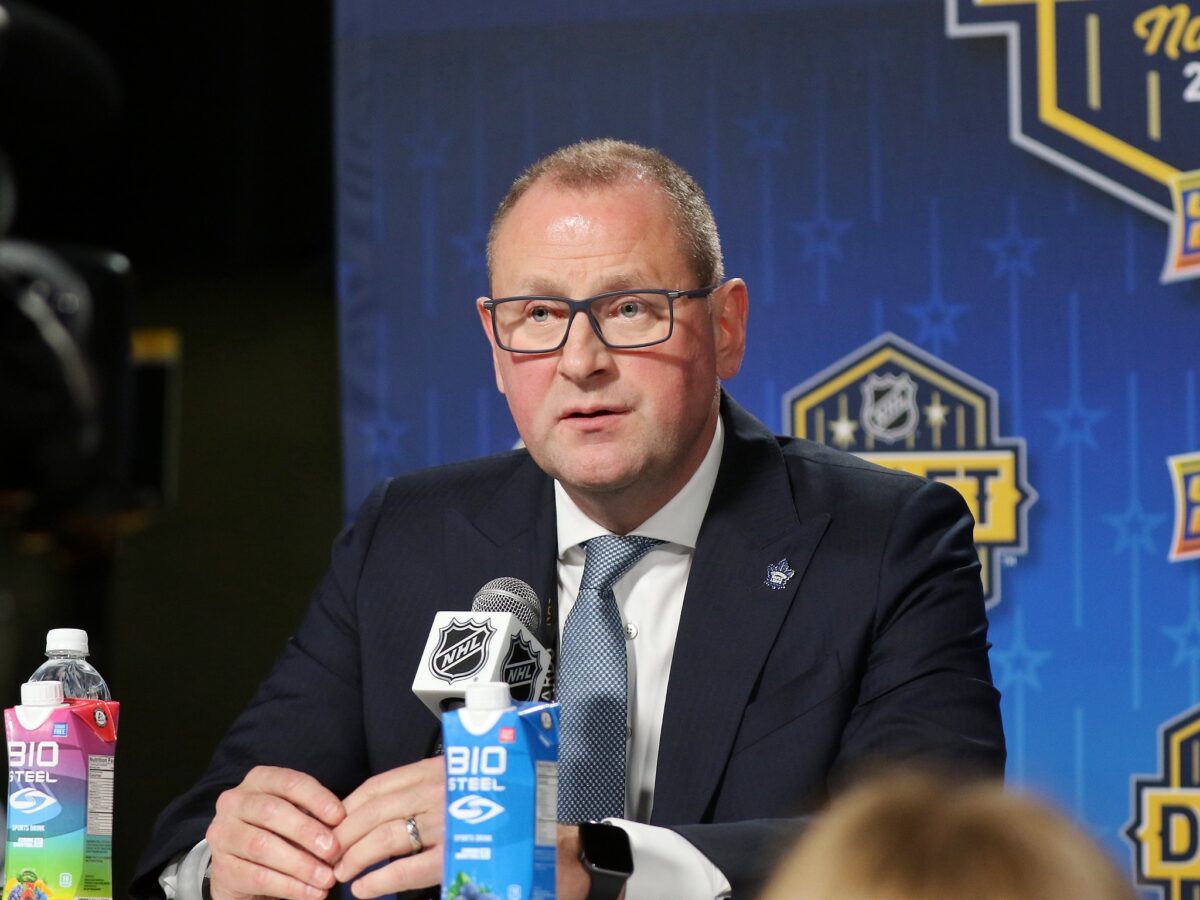Former Toronto Maple Leafs general manager (GM) Kyle Dubas and head coach Sheldon Keefe appeared inseparable for years. Their relationship began when they worked together with the Sault Ste. Marie Greyhounds in the Ontario Hockey League (OHL). Dubas was the GM of the Greyhounds, and Keefe served as the head coach.
Related: Assessing Kyle Dubas’ 2 Years as the Maple Leafs General Manager
That collaboration was a significant part of their early professional careers and laid the foundation for their subsequent partnership with the Maple Leafs organization. Together, they succeeded in developing players and implementing their hockey philosophies, which carried over into their roles with the American Hockey League (AHL) Toronto Marlies and, eventually, the Maple Leafs. Their shared experiences in Sault Ste. Marie helped forge a strong bond and mutual understanding that continued to shape their approach to hockey management and coaching at the NHL level.
Dubas & Keefe Tried to Build a Team That Was Based Upon Speed and Puck-Possession Hockey
Eventually, when Dubas fired Mike Babcock and made Keefe the team’s head coach, they were able to fuse their philosophies in leadership roles with the Maple Leafs. An analytics guy, Dubas favoured a puck-moving, puck-possession style offensively and defensively, often prioritizing smaller, more agile defencemen who could disrupt passing lanes. Four attributes of the style of hockey he believed in were (1) puck control, (2) finding skaters who possessed speed and agility, (3) passing and playmaking, and (4) offensive zone domination.
Specifically, the main key to playing good puck-possession hockey was maintaining control of the puck. Dubas and Keefe’s Maple Leafs teams prioritized clean puck handling, minimizing turnovers, and making smart decisions when they had possession. By controlling the puck, they believed their teams could dictate the game’s flow and create offensive opportunities while limiting the opponent’s chances.
Second, building a team based upon this philosophy prioritized strong skating and agility. Players must be able to maneuver quickly on the ice, evading defenders and creating space for passing and shooting. The Maple Leafs sought agile players who could navigate through traffic, accelerating and changing directions swiftly to maintain possession and create scoring chances.
Related: Assessing Keefe’s Tenure as Maple Leafs’ Head Coach
Third, the players the Maple Leafs brought to the team had to be effective passers and playmakers. Puck possession hockey focuses on quick, accurate passing to maintain offensive pressure and generate scoring opportunities. Such quick, creative passes could take advantage of gaps in the defence, allowing players to capitalize on openings and create high-percentage scoring chances.
Fourth, and finally, successful puck-possession teams excelled in controlling play in the offensive zone. They prioritized sustained pressure, cycling the puck along the boards, and generating shots on goal. By maintaining possession in the offensive zone, puck-possession teams sought to wear down opponents, force defensive breakdowns, and create scoring opportunities through extended offensive possessions. The deal was that the other team couldn’t score if they didn’t have the puck in the Maple Leafs’ defensive zone.

When they first partnered with the Maple Leafs (Dubas as the team’s GM and Keefe as the head coach), their teams were built around controlling the puck, utilizing strong skating and passing skills, and dominating offensive play to create scoring opportunities and dictate the game’s tempo. Using these key principles, they hoped their teams could maintain control, generate offence, and limit the opponent’s chances, ultimately leading to success. While it worked in the regular season, it was less than successful during the playoffs.
This Season, New GM Brad Treliving Has Brought a Different Philosophy of Team Building
In contrast, new Maple Leafs GM Brad Treliving, who is a former defenseman himself, brings with him a different philosophy for team-building. He prefers bigger, rugged, and physical defencemen who excel in clearing the crease and playing a more traditional defensive game. Given coach Keefe’s reactions this season, there’s a sense that Treliving’s shift in player preference is aligning closely with his coaching philosophy. That philosophy, which seemed to first reveal itself with Keefe’s desire to build a shutdown third line around defence-first center David Kampf, fits with Treliving’s defensive-first mindset.
As the team evolved this season under Treliving, philosophical differences emerged between Keefe’s coaching style and Dubas’ approach to team-building. Heading into the 2024 postseason, the Maple Leafs are showing a new identity shaped by Treliving’s influence. At the trade deadline, he made strategic moves to add size and physicality without sacrificing future draft assets. This approach contrasts with Dubas’ tendency to make more aggressive, all-in moves, often involving losing significant draft capital and prospects.
Related: Today in Hockey History: April 6
Keefe appears to be embracing this new direction, seeking effectiveness in a team that aligns more closely with his defence-first coaching philosophy. As the Maple Leafs enter the playoffs with a blend of defensive depth and offensive skill, the philosophical differences between Dubas’ approach and the current direction under Treliving and Keefe are becoming more apparent, shaping the team’s identity and strategy for postseason success.
This Season’s Result, a More Versatile Defence
The two biggest deals Treliving made at the trade deadline were the acquisition of two physical defensive defencemen, Ilya Lyubushkin and Joel Edmundson. With Jake McCabe and Simon Benoit already on the roster, the Maple Leafs now have four big physical defencemen.
At the other end of the physicality spectrum, the team has Morgan Rielly, TJ Brodie, Timothy Liljegren, Mark Giordano, and Conor Timmins. These players can be physical but are not known for their physicality. Rielly, of course, is best known for his offensive strengths. Brodie and Giordano are known for their shot-blocking and first-pass abilities. Liljegren and Timmins are decent puck handlers and passers who are competent defensively. All four players are also better skaters and more mobile than the physical group.

With the present combination of nine players, the Maple Leafs could ice two completely different types of defence. Rielly is the one player who will play regardless of what type of defence the team wants to use. He is their number-one defenceman offensively and one of their core five players.
What Defence Is the Best? Big and Physical or Puck Control and Mobility?
If the Maple Leafs want to emphasize their physicality and make life miserable for opposing players, they could have McCabe, Edmundson, Lyubushkin, and Benoit join Rielly. Then they could add one of Timmins, Liljegren, Giordano, or Brodie to round out the six defencemen in a game.
If the Maple Leafs wanted to emphasize speed, puck control, and mobility, they could go with Brodie, Giordano, Liljegren, and Timmins and add one of McCabe, Edmundson, Lyubushkin, or Benoit. McCabe appears to be the best skater and puck handler in the physical group, so he would most likely get the nod.
Related: Top 3 All-Time Oilers Goalies
Truthfully, Maple Leafs fans won’t likely see either an “all-physical” defensive lineup or an “all-mobile” lineup. It will most likely be a combination of both. But with these nine players, Keefe now will have options to move his defensive core in one direction or the other. The defence that enters this postseason differs in big ways from those that entered previous seasons.
Now the question remains, will it matter to the Maple Leafs’ postseason success?
[Note: I want to thank long-time Maple Leafs fan Stan Smith for collaborating with me on this post. Stan’s Facebook profile can be found here.]
